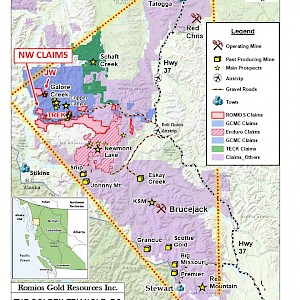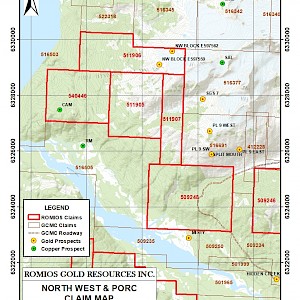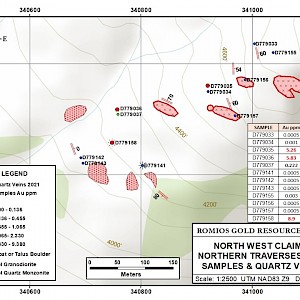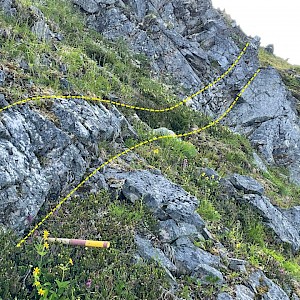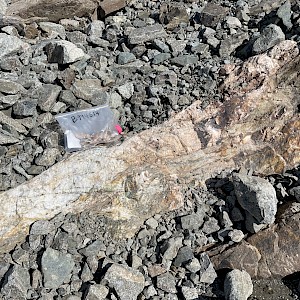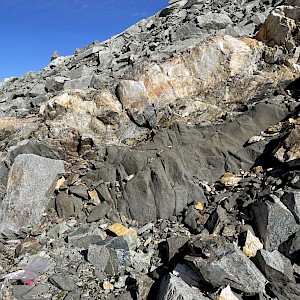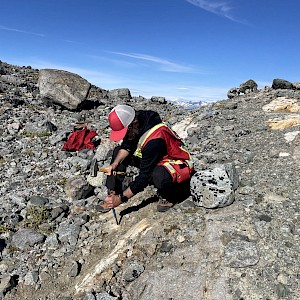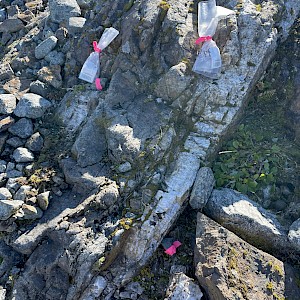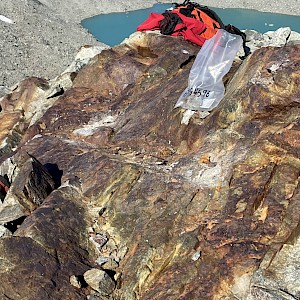North West and Porc Claim Block
-
Overview
Property Type- Small gold-bearing quartz veins are now known to occur in the Texas Creek pluton that underlies much of the NE part of the claim block and two minor copper prospects (Cam and the off-claim RM showing) occur in the Stikine Assemblage metasediments that underly the SW half of the claims. Gold-mineralized quartz boulders (5-8 g/t Au) were discovered in 2021 as well as numerous large quartz veins up to 80 cm wide in the nearby outcrops, one of which assayed 5.8 g/t Au. Numerous larger veins and vein sets were located in 2022; assays are pending.
Size- 2,252 Hectares
Status- 100% owned
Exploration Stage
- Romios has conducted several brief mapping and prospecting programs over the North West and/or Porc claims since 2006 as well as airborne Mag-EM surveys in 2007. The current exploration focus is now on the northeastern portion of the North West claims where gold-bearing pyritic quartz veins were discovered in 2010 (1.6 and 16.5 g/t Au) and in 2021 (5 to 8 g/t Au).
Location
- There are four North West claims and the adjoining “PORC” claim (unofficial name) in the “Golden Triangle” area of northwestern British Columbia that make up the North West Claim Block. These are located close to several major undeveloped Cu-Au alkalic porphyry deposits including the giant Galore Creek deposit(s) 9 km to the NE, Copper Canyon 17 km to the ENE and Schaft Creek 49 km to the NE. The partially cleared, proposed road route from highway 37 to the Galore Creek deposits crosses the Porc claim.
-
Geology/Exploration
Highlights Of Key Target Areas
The 2021 sampling and mapping program was concentrated in the northern part of the claims within the Texas Creek pluton. This work was successful in locating some of the most gold-mineralized quartz boulders (5-9 g/t Au) ever found by Romios personnel on these claims as well as numerous large quartz veins up to 80 cm wide in the nearby outcrops, one of which assayed 5.9 g/t Au. All of the gold-bearing veins contained disseminated pyrite as opposed to the barren veins which did not. A semi-regular spacing and orientation of the veins was noted and provides guidance for follow-up work. Further exploration in 2022 located a number of large, locally copper-bearing veins up to 1.2 m wide. Many of these are found within fault zones +/- alongside mafic dykes. Assays from the 2022 work are pending
PAST WORK
June 2006: Romios carried out soil geochemical surveys, mapping and prospecting on the Porc claim and the Royce claim a short distance to the east, claims that covered much of the lapsed PL 8, 10 and 11 claims previously held by Royce Industries (Simmons, 2006). A soil sampling grid was established in the south and central portion of the Porc claim, where previous soil contour-sampling identified poorly constrained areas of multi-element soil anomalies. Prospecting in the southern part of the grid led to the discovery of a folded quartz vein (the Porc vein), which is sporadically mineralized, up to 25 m thick and has been mapped for a strike extent of approximately 400 metres. Several samples of the vein were taken and graded up to 9.61 g/t Au, 998 g/t Ag, 1.93% Pb and 3.49% Zn, however, most of the vein is unmineralized. The vein has an associated 325° trending soil geochemical anomaly which spans the entire grid.
2007: Romios Gold Resources contracted Fugro Ltd. to fly airborne geophysics over the entire claim block with 277 line km flown on the combined Porc-Royce claims and 82 line km on the North West claims using a DIGHEM V electromagnetic system and magnetometer. Both the Magnetic and EM survey results from the North West claims would seem to indicate that there is a major NW-SE contact considerably farther SW than the Stikine-Stuhini-Texas Creek contact location indicated on the regional geology map.
2010: Romios completed property wide mapping and prospecting, follow-up of geophysical anomalies delineated in the 2007 airborne surveys, and geochemical rock sampling (Chadwick, 2010). A total of 9 grab samples were collected in 2010, assaying up to 16.5 g/t Au and 0.547% Cu. The highest gold values came from quartz veins, which exist throughout the property, but contain highly variable amounts of gold and copper. From 2011 to 2014, limited prospecting and sampling were performed on the claims. In 2015, Romios collected 13 rock samples that returned generally low values of Au, Ag and Cu (Close, 2015).
2021: A brief mapping and sampling program was conducted by Romios personnel on the northernmost claims in an area underlain by the Texas Creek pluton. Numerous quartz veins up to 80 cm wide were found at a semi-regular spacing of ~10-20 m. The pyritic margin of one vein assayed 5.8 g/t Au and two boulders of pyritic quartz vein material scattered across a 200 m wide area assayed 5.26 to 8.9 g/t. A large portion of the pluton remains to be explored for additional veins, including the area north of the mineralized boulders where a subsequent SWIR satellite image alteration mineral study identified a broad area of calcite, chlorite-epidote, montmorillonite and sericite alteration.
In addition to the summer field work discussed above, a specialist firm was contracted in late 2021-early 2022 to acquire and interpret SWIR (Short Wave Infrared) satellite imagery of these claims in order to identify various alteration minerals that might be related to mineralizing systems. This work identified a number of prominent mineral anomalies (epidote/chlorite, sericite) in the northeast corner of the claims.
2022: Further exploration of the northeastern portion of the claims was conducted for 2 days in 2022 in an effort to locate larger mineralized veins. This work was successful in locating several large quartz veins up to 1.2 m wide, some with visible copper-staining and/or in the vicinity of previously sampled veins that proved to be gold-bearing. Many of these newly discovered veins are developed within fault structures, some of which are intruded by basalt or lamprophyre dykes, and these veins may have much more continuity and size potential than typical fracture controlled veins as a result. Assays from 2022 are pending. Examination of the SWIR alteration mineral anomalies was inconclusive. Epidote alteration was observed in some areas but the degree of alteration seems insufficient to explain the apparently strong anomalies.
Conclusions
As noted above, the 2021 mapping and prospecting program on Romios’ North West claims returned gold assay results that are some of the highest from any samples ever collected on these claims by Romios or other parties that we know of. These results came from a number of pyritic quartz veins in boulders and one outcrop in the far northeast corner of the claim block, an area underlain largely by granitoids of the Texas Creek Plutonic Suite. Numerous large, somewhat regularly spaced quartz veins up to 80 cm wide were found throughout the area although only those with minor disseminated pyrite returned significant gold assays, up to 8.9 g/t Au. In 2010, Romios personnel collected several mineralized quartz vein samples ~800 to 1200 metres north of the mineralized 2021 samples, one of which assayed 16.5 g/t Au.
The 2022 exploration program was successful in locating a number of large, apparently structurally controlled quartz veins up to 1.2 m wide with local copper mineralization. Some veins are near previously sampled, high-grade gold veins and the presence of copper mineralization in other, newly explored areas, may be a positive indicator of elevated gold values there as well. Assays are pending.
The alteration mineral maps of this claim block, produced by geophysical analysis of the SWIR data from WoldView-3 satellite imagery on Romios behalf by a contractor, depict overlapping calcite, chlorite-epidote, montmorillonite and sericite concentrations in the far NE corner of the claims, predominantly to the north of the 2021 traverse area where the gold-bearing veins were located. A field examination of some of the most anomalous areas was included in the 2022 work. Although locally abundant epidote alteration was noted in the plutonic rocks, the amount and extent of it does not appear unusual for this region. It may be that the apparently strong SWIR anomalies in much of this area are due to glacial rock flour or other factors unrelated to mineralized systems.
-
Press Releases

